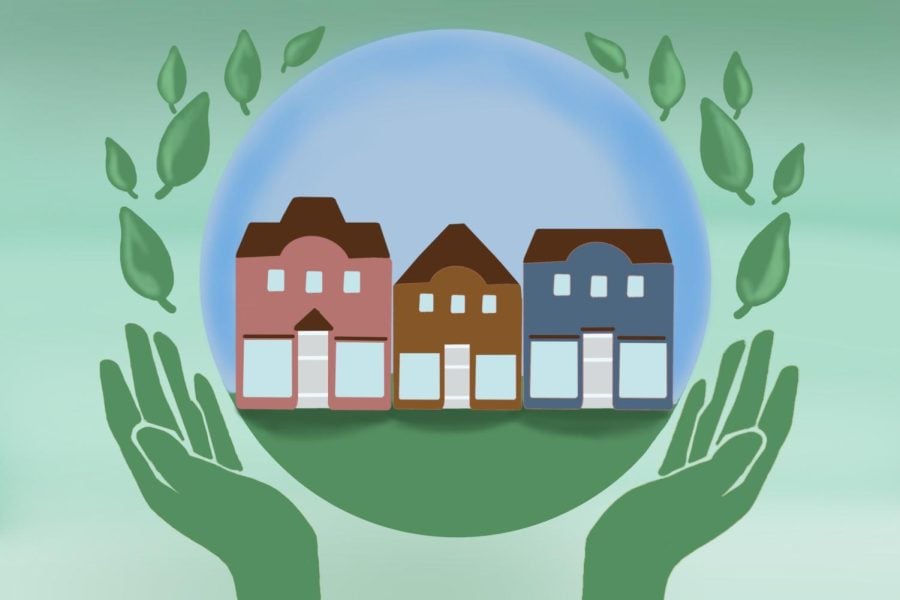As Evanston works to cut carbon emissions, locals say affordable solutions are key
Evanston residents expressed concerns over an ordinance that would phase out natural gas at a Wednesday night town hall.
May 21, 2023
Eighth Ward resident Jane Neumann recently installed solar panels on her home — a “pretty easy” choice for her household — she said. Yet solar panels aren’t as common a sight in her neighborhood as they are in other parts of the city, she’s noticed.
In wards of the city with higher concentrations of wealthy residents, clean energy systems are far more visible, she said.
“You drive around neighborhoods and just look around — the north end of Evanston has a few more solar systems,” Neumann said.
Home energy-efficiency upgrades, like solar panels and heat pumps, have long been praised as a key way to cut carbon emissions in housing, which city Sustainability and Resilience Coordinator Cara Pratt said is one of Evanston’s biggest sources of emissions.
Yet many of these technologies require upfront investments of tens of thousands of dollars.The average solar panel installation in Illinois can cost more than $12,000, even with federal tax credits, according to a May report from Forbes.
If she was still financially focused on raising her children or saving for retirement, Neumann said, it would’ve been much more difficult to prioritize an investment in green technology.
As Evanston pushes toward carbon neutrality through its Climate Action and Resiliency Plan, government leaders and advocates are looking to make energy-efficient upgrades more accessible for lower-income residents.
With officials looking to bridge the gap between affordability and efficiency, some residents said the city needs to prioritize the former.
“If our society is to make more energy efficiency a high-enough priority, (the city) needs to attach some dollars to that in a significant way,” Neumann said.
A main way the city is working to make energy efficiency more affordable for homeowners is through its One Stop Shop Housing Retrofit pilot program. The program will use American Rescue Plan Act funding to help income-qualified residents make home improvement upgrades to their electrical, mechanical, heating and cooling systems.
According to Robinson Markus, worker-owner and general manager at the Evanston Development Cooperative, the goal of the program is to ensure residents and landlords do not have to pay out of pocket for sustainable home upgrades.
Pratt said the One Stop Shop upgrades will focus on “improved health outcomes, energy efficiency, reduced carbon emissions (and) reduced utility bills.”
The program’s pilot is set to launch in the next few months. It will serve up to 50 Evanston households in two census tracts, located in the 5th and 8th wards, which Markus said have higher concentrations of affordable housing units, low-income residents and residents of color.
Bob Dean, chief strategy and program officer for the Center for Neighborhood Technology, said organizers are also looking at state and federal grants in hopes of securing long-term funding for the One Stop Shop program.
While 50 homes is “a drop in the bucket” in terms of addressing the need for affordable housing improvements, Dean said, he hopes to make the program “bigger and better” in the coming years.
“Evanston is a pretty residential city, and so you really have to do something about housing stock in order to get us on a good path,” he said.
With opportunities like the One Stop Shop still waiting to launch, more residents have been looking into ways to install their own energy-efficient systems.
Ninth Ward resident Jeff Balch’s home has had solar panels on its roof since he moved into it in 1996. While the original solar panels were installed by the last homeowner, Balch recently upgraded them after they were damaged during a storm.
Balch said seeing solar panels on just one home can spark interest by neighbors, creating a domino effect.
“There are, I think, five homes within a couple hundred yards of our house that have solar and got it in the last couple of years,” Balch said. “We’ve had a number of calls from friends who see our system, and they’ve come by and they’ve asked for an explanation.”
While upfront costs for technologies like solar panels remain high, homeowners like Balch and Neumann said they’ve gotten significant savings in the long term. Because buildings with solar panels produce much of their own energy, residents don’t have to pay typical amounts on electric bills.
Contractors often refer to a “payback period” for solar panels. If residents use them for several years, they will often save enough from not paying energy bills to offset the initial cost of solar panel installation. In Illinois, the average payback period for solar panels is less than nine years.
There’s still an “activation energy” needed to get residents educated about the economic benefits of solar panels, Balch said. And local groups like Climate Action Evanston alongside residents and city officials, are trying to figure out ways to boost awareness of sustainable technology, according to CAE Energy Program Lead Joel Freeman.
“We’re trying to make this transition (to clean energy) into a strategic plan, as opposed to an emergency,” Freeman said.
Email: [email protected]
Twitter: @lilylcarey
Related Stories:
— Residents, local activists convene to discuss climate friendly home improvements
— Citizens Greener Evanston changes name to Climate Action Evanston
— Evanston climate community reconnects, plans for future together


